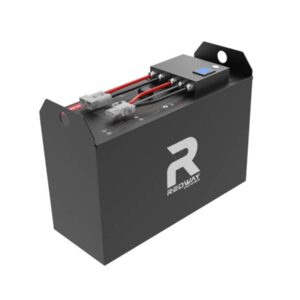What destroys a lithium-ion battery?
Lithium-ion batteries degrade or fail due to thermal stress (exceeding 60°C), voltage extremes (overcharging >4.2V/cell or deep discharging <2.5V), mechanical damage causing internal shorts, and improper charging cycles. Dendrite growth from repeated fast charging and calendar aging (3-5% annual capacity loss) also contribute. Always use temperature-controlled charging and avoid storing at full charge to prevent accelerated degradation.
How to Maximize Forklift Battery Lifespan
How does excessive heat damage lithium batteries?
Prolonged heat exposure above 45°C triggers electrolyte decomposition and SEI layer thickening, reducing ion mobility. At 60°C+, cathode oxidation accelerates, while anode graphite destabilizes, risking thermal runaway. Pro Tip: Install battery packs away from motors/heat sinks and use PCMs with NTC sensors.

Thermal stress initiates three failure modes: 1) Electrolyte vaporization (boiling point: ~80°C for EC/DMC solvents), creating gas pockets; 2) Separator shrinkage (PE melts at 130°C), causing internal shorts; 3) Cathode breakdown (NMC releases oxygen at 200°C). For example, a 18650 cell left in a 70°C environment loses 40% capacity in 3 months. Transitional phases like nickel-rich cathodes exacerbate heat sensitivity—always prioritize active cooling in high-load applications.
Why is overcharging catastrophic for Li-ion cells?
Overcharging forces excess lithium ions into anodes, causing metallic plating (dendrites) that pierce separators. Voltages above 4.25V/cell oxidize electrolytes, generating CO2 and ethane gas. Pro Tip: Use chargers with ±1% voltage accuracy and redundant BMS overvoltage protection.
When cells exceed their upper voltage limit (3.6V for LiFePO4, 4.2V for NMC), the cathode becomes hyper-lithiated, destabilizing its crystal structure. For instance, overcharging a 3.7V NMC cell to 4.5V increases internal pressure by 300kPa, often rupturing safety vents. Transitional systems like Tesla’s BMS automatically isolate overvoltage cells, but repeated abuses still degrade capacity by 15-20% per incident. Furthermore, plated lithium reacts exothermically with electrolytes, creating chain reactions that bypass protection circuits.
| Chemistry | Safe Charge Voltage | Overcharge Risk Threshold |
|---|---|---|
| LiFePO4 | 3.65V/cell | >3.8V/cell |
| NMC | 4.2V/cell | >4.3V/cell |
Can physical impacts permanently damage Li-ion batteries?
Mechanical stress—crushing, punctures, or bends—compromises cell integrity, creating internal shorts between layers. Even minor separator tears (<1mm) enable micro-shunts that drain capacity. Pro Tip: Use shock-absorbing mounts in EVs and avoid stacking batteries vertically.
A 5mm indentation on a prismatic cell can increase internal resistance by 30% within 50 cycles. When the jellyroll structure deforms, electrode delamination occurs, disrupting ion pathways. For example, a dropped smartphone battery with a dented corner may show sudden voltage drops from 3.7V to 2.1V under load. Practically speaking, manufacturers conduct nail penetration tests (UL1642) to simulate shorts—failed units combust within 60 seconds. Transitional safety measures include using ceramic-coated separators or steel-cased cylindrical cells for impact resistance.
How does deep discharging degrade battery health?
Discharging below 2.5V/cell dissolves copper current collectors into electrolytes, creating conductive metal shunts. The anode’s SEI layer also breaks down, exposing graphite to parasitic reactions. Pro Tip: Set BMS low-voltage cutoffs at 2.8V/cell with 0.2V hysteresis.
At <2V, copper oxidation releases ions that migrate to the anode, reducing cyclable lithium. A single deep discharge (e.g., leaving an EV uncharged for winter) can permanently lose 5-7% capacity. Consider a 100Ah NMC pack discharged to 0%: its internal resistance may spike from 25mΩ to 80mΩ, crippling peak current delivery. Transitional solutions like reserve capacity modes in EVs maintain a 10-15% charge buffer—think of it as a “mechanical reserve” similar to fuel tanks avoiding complete emptiness.
| Depth of Discharge (DoD) | Cycle Life (NMC) | Capacity Retention (2yrs) |
|---|---|---|
| 100% | 500 cycles | 70% |
| 80% | 1,200 cycles | 85% |
What role does calendar aging play in battery death?
Passive degradation occurs even during storage—electrolytes slowly decompose into HF gas, corroding electrodes. LiFePO4 loses ~2% annual capacity; NMC degrades 4-6% yearly at 25°C. Pro Tip: Store batteries at 40-60% charge in 15°C environments to minimize aging.
Calendar aging stems from two mechanisms: 1) SEI growth consuming lithium ions, and 2) Electrolyte oxidation reducing ionic conductivity. A study showed NMC811 cells stored at 40°C/100% charge lost 32% capacity in 18 months—twice the loss of those stored at 20°C/50%. Transitional approaches like solid-state electrolytes (e.g., Samsung’s sulfide-based designs) aim to halve aging rates by eliminating liquid decomposition pathways. But realistically, even unused EV batteries expire in 8-10 years due to cumulative parasitic reactions.
Battery Expert Insight
FAQs
Can one overcharge event destroy a battery?
Not always, but it causes irreversible damage. Overcharging to 4.35V (NMC) reduces capacity by 8-12% immediately. Repeated events risk thermal runaway.
Is it safe to use a swollen Li-ion battery?
No—swelling indicates internal gas buildup from electrolyte breakdown. Replace immediately to avoid rupture or fire.
Do all lithium batteries degrade at the same rate?
No—LiFePO4 retains 80% capacity after 3,000 cycles vs. NMC’s 1,500. But NMC offers higher energy density (200-250Wh/kg vs. 120-160Wh/kg).
